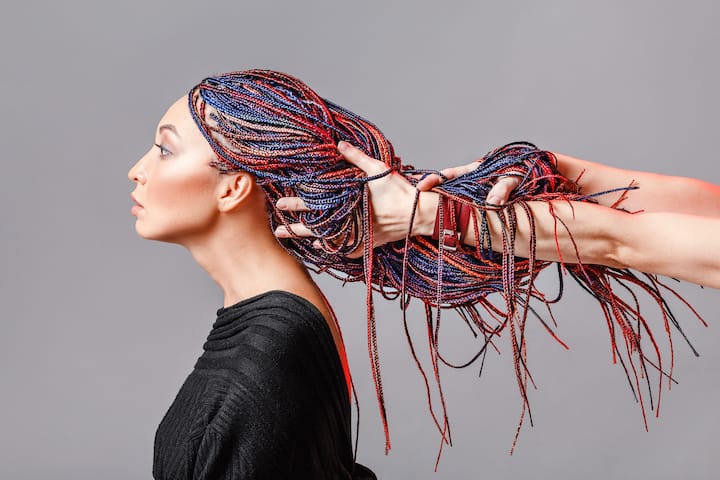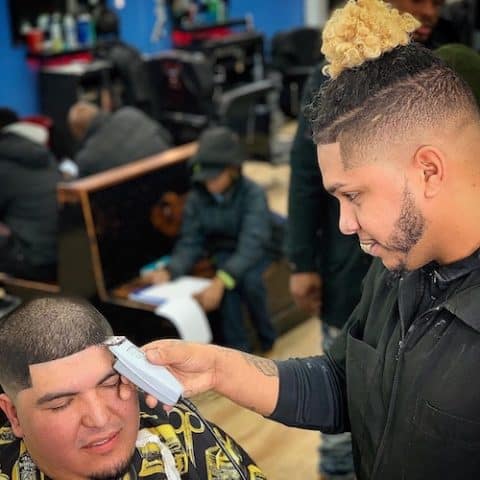In this article, we’ll dive into the five stages of growing dreadlocks and explore the factors that can affect the time it takes to lock your hair.
Plus, we’ll share some tips on how to make your hair locs grow faster and maintain your dreadlock hairstyles.
Table Of Contents
How Long Does It Take to Grow Dreads
So, how long does it take for your dreads to grow? Well, the answer to that question depends on various factors.
First and foremost, it is essential to note that dreadlocks cannot be achieved overnight. Hair growth varies from person to person, but on average, it can take anywhere from six months to a year for your dreads to fully mature.
This timeline may seem long, but it is essential to understand that growing dreads require patience and commitment. You must invest time and effort into maintaining your dreadlocks regularly, such as separating the strands and retwisting them.
5 Stages of Growing Dreadlocks
When it comes to growing dreadlocks, there are several stages that you will go through. First is the starter stage, where you begin locking your hair.
Then, your dreads will enter the budding stage, where they start to take shape and form. After that, they will progress into the teen stage, becoming more mature and developing their own unique character.
Finally, your dreads will reach the mature stage, fully formed and have settled into their natural pattern. At this point, your dreads are rooted and have become a permanent part of your hair journey.
Starter
You should consult a professional stylist to get started on growing dreads. They will guide you through the journey of dreadlock growth and help you understand the stages involved.
The first stage of growing dreads is the starter phase. During this phase, your stylist will create the foundation for your dreads by sectioning your hair and using a unique technique to encourage the hair to lock together. This is an essential step as it sets the groundwork for the growth of your dreads.
As your hair grows, you will notice the growth phase of your dreads. This is when your hair matures and locks together naturally, forming the iconic dreadlock look. Your stylist will provide advice and maintenance tips to ensure healthy growth and encourage the desired look for your dreads.
Budding
During the budding phase, you’ll notice small sections of your hair forming into individual dreadlocks. This is an exciting stage in the growth of your dreads, as it signifies progress and development.
As your hair grows, these budding sections become more defined and distinct, eventually forming into fully matured dreadlocks. It’s essential to be patient during this process, as the time it takes for your dreads to fully grow can vary depending on various factors, such as your hair type and length.
However, with proper maintenance and regular care, you can encourage the growth of your dreads and ensure they reach their full potential.
Teen
As a teenager, your hair may grow at a faster rate compared to other age groups. This is because, during adolescence, your body undergoes hormonal changes that can stimulate hair growth.
The speed at which your hair grows depends on various factors, including genetics, diet, and overall health. Hair textures vary among individuals, so the growth process may differ. Some teenagers may have straight hair that grows quickly, while others may have curly or kinky hair that appears to grow slower due to its coiled nature.
Regardless of your hair texture, maintaining healthy hair habits, such as regular washing, conditioning, and protecting it from heat and damage, can help promote optimal hair growth and length retention.
Mature
You may notice changes in your hair as you mature. These changes can include decreased oil production and a potential increase in gray hairs.
The process of growing dreads can vary depending on your hair type, length, and maintenance routine. Generally, it takes about six months to a year for dreads to fully mature and lock. During this time, your hair will go through different stages, from loose coils to tighter knots.
It’s essential to be patient and avoid manipulating your hair too much, as this can delay the locking process. Regularly washing and conditioning your dreads and retwisting or palm rolling them can help promote healthy growth and prevent them from unraveling.
Rooted
Growing mature dreads can be a journey that requires patience and proper care.
When it comes to growing your dreads, paying attention to the roots of your hair is essential. As your dreads grow, the roots will be your hair’s newest and least mature part.
To ensure that your dreads are firmly rooted, it’s essential to properly section your hair and maintain regular maintenance. By separating your hair into sections and twisting or backcombing each section, you encourage your hair to grow into individual dreads.
This process allows the roots to intertwine and bind, creating solid and healthy dreads. Remember to be gentle with your roots, as they are delicate and prone to breakage.
With time and care, your dreads will grow and become rooted, giving you the mature look you desire.
Factors That Affect How Long It Takes to Lock Your Hair
When it comes to how long it takes for your hair to lock into dreads, there are several factors to consider. First, your hair texture plays a significant role in the process. Coarser hair tends to lock faster, while finer hair may take longer.
Additionally, your overall health can affect how quickly your hair locks, as healthy hair is more resilient and can withstand the manipulation required for dreadlocks. Lastly, how you section your scalp also plays a part, as evenly sized sections can promote more uniform locking and prevent uneven growth.
Your Hair Texture
Depending on your hair texture, dreads can take varying amounts of time to grow. Your hair texture is crucial in how quickly your dreads will form and reach the desired length.
If you have coarse and thick hair, your dreads may grow faster than those with fine and straight hair. Your hair’s natural texture affects how well it knots and holds the dreads together. Coarse hair tends to lock up quicker because the strands have more texture, making it easier for them to intertwine.
On the other hand, fine and straight hair may take longer to form dreads as the individual hair strands are smoother and less prone to tangling.
Your Health
Now that you understand how your hair texture affects the process of growing dreads, let’s talk about the role your health plays in this journey.
Your overall health is crucial for promoting hair growth and maintaining healthy dreads. Your hair reflects your internal well-being, so eating a balanced diet rich in vitamins and minerals is essential.
Drink plenty of water to keep your hair and scalp moisturized. Regular exercise improves blood circulation, which stimulates hair growth. Also, managing stress is vital as high stress levels can lead to hair loss.
How You Sectioned Your Scalp
To achieve well-defined sections in your scalp, using a comb, it’s important to part your hair in straight lines. This will create neat and organized sections for your dreads to grow.
Start by dividing your hair into equal sections using the teeth of the comb. Comb through each section thoroughly to detangle any knots or tangles. Take your time and be patient, as this process is crucial for the overall appearance of your dreads.
You can begin growing your dreads once you have successfully sectioned your scalp. Remember to maintain proper hair care routines, such as regular washing and moisturizing, to ensure healthy and robust dreads that will continue to grow beautifully.
How to Make Your Hair Locs Grow Faster
If you want your hair locs to grow faster, it’s crucial to maintain a healthy scalp. Caring for your scalp is essential because it provides the foundation for hair growth.
Keep your scalp clean by washing it regularly with a gentle shampoo to promote faster growth. Avoid using harsh chemicals or products that can strip your hair of its natural oils.
Massage your scalp daily to stimulate blood circulation and encourage hair follicles to produce new growth. Additionally, nourish your hair from the inside out by eating a balanced diet of vitamins and minerals.
How to Maintain Dreadlock Hairstyles
To maintain your dreadlock hairstyle, it’s important to regularly wash your hair and keep it clean. Dreads require special care to keep them looking neat and healthy.
Start by washing your hair with a residue-free shampoo explicitly designed for dreadlocks. Gently massage your scalp to remove any dirt or build-up. Be sure to rinse your hair thoroughly to avoid leaving any residue behind.
After washing, use a towel to gently squeeze out excess water, but avoid rubbing or twisting your dreads.
To maintain your dreads, you can palm roll them regularly to help them lock and tighten. Avoid using products that contain oils or heavy conditioners, as they can cause build-up and prevent your dreads from maturing.
With proper care and maintenance, your dreadlock hairstyle will continue to grow and look great.
FAQ
Can I start my dreadlocks with short hair?
Yes, you can start your dreadlocks with short hair. It may take longer for them to fully form, but your hair will eventually grow into beautiful dreads with proper maintenance and patience.
Can I speed up the dreadlocking process by using hair products?
You can’t speed up the dreadlocking process with hair products. It’s a natural process that takes time. However, certain products and techniques can help maintain and promote healthy dread growth.
How often should I wash my dreadlocks?
You should wash your dreadlocks every 1–2 weeks to keep them clean and healthy. Regular maintenance is important to prevent buildup and maintain the integrity of your locks.
Is it possible to undo or remove dreadlocks?
Yes, it is possible to undo or remove dreadlocks. However, the process can be time-consuming and may require cutting or combing out the hair. It’s best to consult a professional for assistance.
Are there any specific hairstyles I should avoid while growing my dreadlocks?
While growing your dreadlocks, avoiding hairstyles that put excessive tension or strain on your hair is best. Styles like tight ponytails or buns can hinder the natural growth and potentially damage your locks.
Jay is one of the members of the Beardoholic writers team and NFL, celebrity barber. As a master barber with years of experience, Jay can make your beard look any way you envision. Jay’s specialty is black men’s hair and beard styles, but he also has deep knowledge on how to create a perfect neck and cheek line, short or long beard and virtually any beard and hair shape and style.


